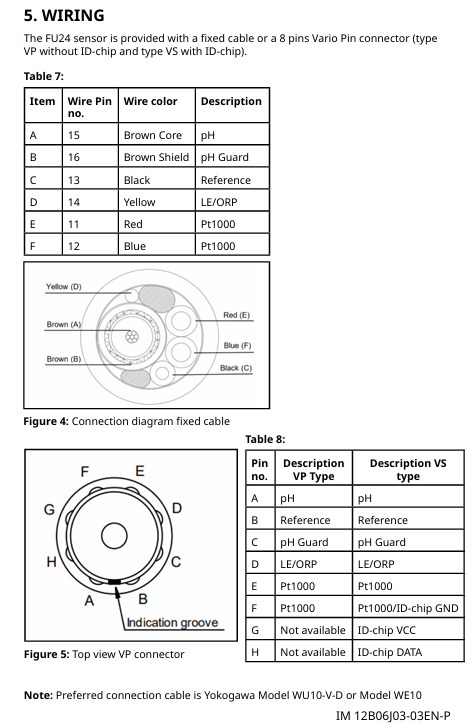YOKOGAWA FU24 pH/ORP Composite Sensor with Pressure Compensation (IM 12B06J03-03EN-P)
Explosion proof certification failure: 1. Cable damage; 2. Replace non original spare parts; 3. Installation does not meet the requirements of the control diagram; 1. Replace the original factory cable; 2. Only use Yokogawa certified spare parts; 3. Reinstall according to the D&E 2020-023-A50/A51 control diagram;
2. Key spare parts list
Spare parts model, purpose, applicable scenarios
K1521JA/JB sensor installation bracket JA (stainless steel) JB(PVDF), Compatible with FF20-S3/F3 series mounting components, 1-inch NPT interface;
K1520BA~BE pH buffer solutions BA (4.01+6.87+9.18, 3 × 0.5L), BC (4.01 separately), etc., comply with IEC standards;
WU10-V-D-XX Vario Pin cable XX is length (2/5/10m), suitable for VP/VS type sensors, connected to transmitters;
The SA11-P1 smart adapter is only compatible with VS type sensors, stores calibration data, and supports HART communication;
BA11 active junction box is used for remote installation of VS type sensors, achieving signal amplification and anti-interference;
Chemical compatibility and compliance
1. Material compatibility
The chemical compatibility of the sensor's contact medium components needs to match the process medium, and the tolerance range of the core material is as follows:
Material resistant medium taboo medium
PPS 40GF (main body) mostly contains acid, alkali, salt solutions (such as 50% sulfuric acid, 40% sodium hydroxide), strong oxidizing media (such as fuming nitric acid), and halogenated hydrocarbons;
Viton (seal) mineral oil, most organic solvents ketones, amines, low molecular weight esters;
PTFE (reference end) has no significant contraindications for almost all chemical media (except for molten alkali metals);
Glass (measuring end) weak acid, neutral medium hydrofluoric acid (concentration>40%), concentrated alkali (>50%);
2. Compliance requirements
RoHS compliance: compliant with EU Directive 2011/65/EU, restricting harmful substances such as lead and cadmium;
WEEE compliance: As a component of industrial fixed equipment, it needs to be recycled and disposed of in accordance with national regulations (such as the EU WEEE Directive);
Installation compliance: Installation in hazardous areas must comply with local electrical codes (such as NFPA 70 in the United States and CEC CSA22.1 in Canada), with a grounding resistance of ≤ 1 Ω.

- EMERSON
- Honeywell
- CTI
- Rolls-Royce
- General Electric
- Woodward
- Yaskawa
- xYCOM
- Motorola
- Siemens
- Rockwell
- ABB
- B&R
- HIMA
- Construction site
- electricity
- Automobile market
- PLC
- DCS
- Motor drivers
- VSD
- Implications
- cement
- CO2
- CEM
- methane
- Artificial intelligence
- Titanic
- Solar energy
- Hydrogen fuel cell
- Hydrogen and fuel cells
- Hydrogen and oxygen fuel cells
- tyre
- Chemical fiber
- dynamo
- corpuscle
- Pulp and paper
- printing
- fossil
- FANUC
- Food and beverage
- Life science
- Sewage treatment
- Personal care
- electricity
- boats
- infrastructure
- Automobile industry
- metallurgy
- Nuclear power generation
- Geothermal power generation
- Water and wastewater
- Infrastructure construction
- Mine hazard
- steel
- papermaking
- Natural gas industry
- Infrastructure construction
- Power and energy
- Rubber and plastic
- Renewable energy
- pharmacy
- mining
- Plastic industry
- Schneider
- Kongsberg
- NI
- Wind energy
- International petroleum
- International new energy network
- gas
- WATLOW
- ProSoft
- SEW
- wind
- ADVANCED
- Reliance
- YOKOGAWA
- TRICONEX
- FOXBORO
- METSO
- MAN
- Advantest
- ADVANCED
- ALSTOM
- Control Wave
- AB
- AMAT
- STUDER
- KONGSBERG
- MOTOROLA
- DANAHER MOTION
- Bently
- Galil
- EATON
- MOLEX
- Triconex
- DEIF
- B&W
- ZYGO
- Aerotech
- DANFOSS
- KOLLMORGEN
- Beijer
- Endress+Hauser
- MOOG
- KB
- Moxa
- Rexroth


Email:wang@kongjiangauto.com






















































































































